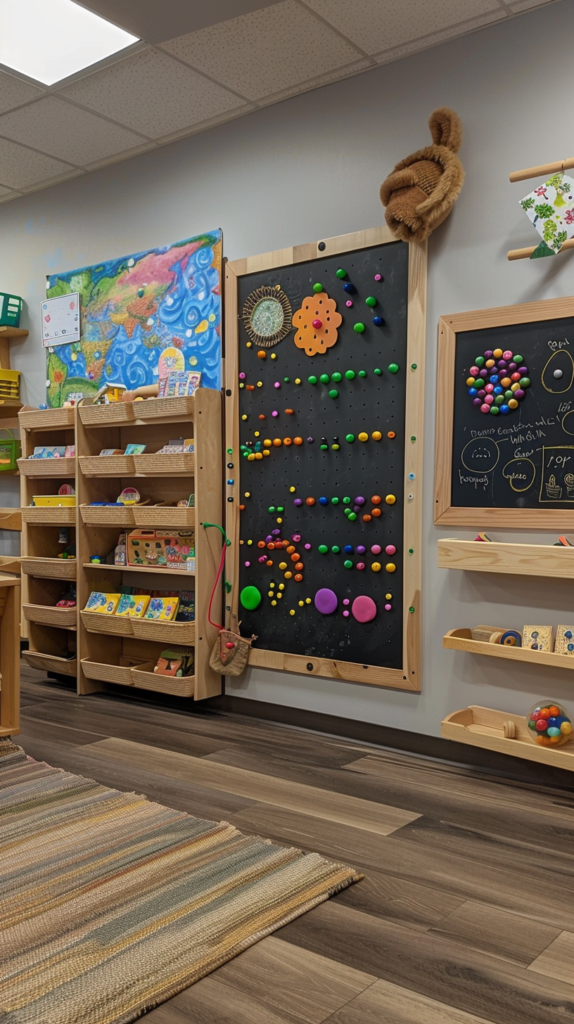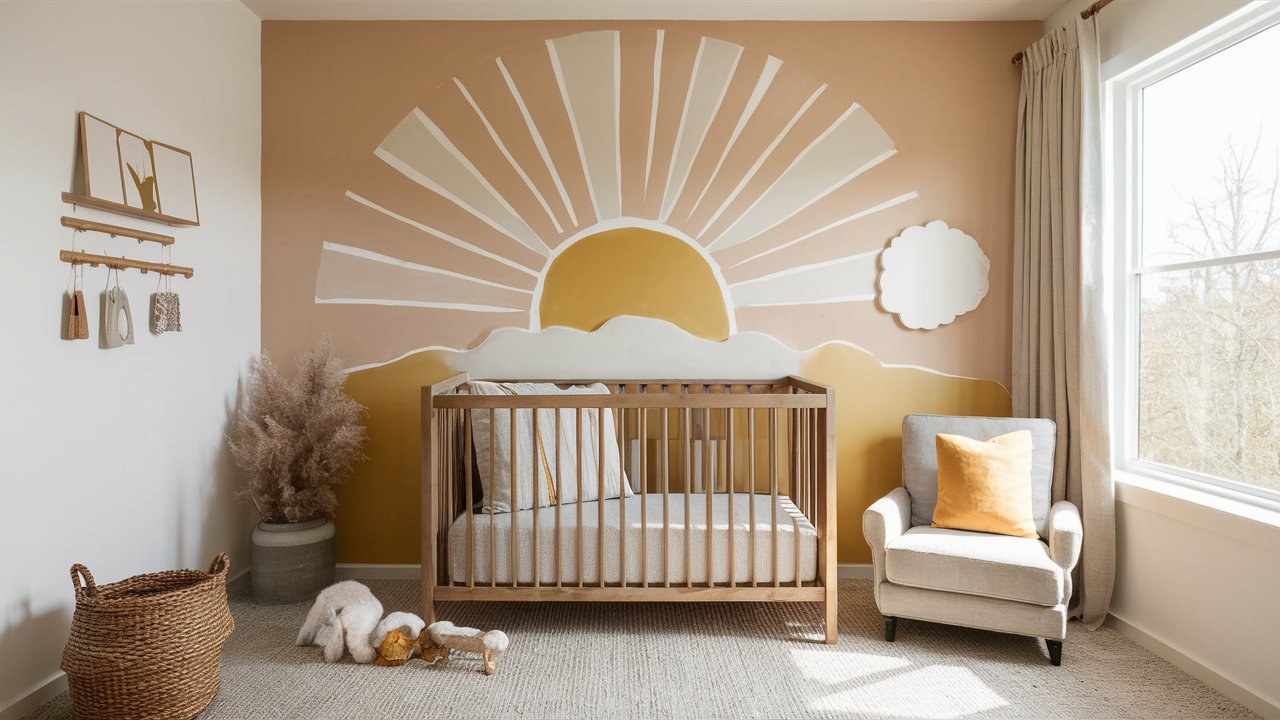Disclosure: Some links on this site are affiliate links. As Amazon Associates, we earn from qualifying purchases (at no cost to you).
Creating a Montessori bedroom for babies and toddlers focuses on fostering independence, safety, and creativity.
The Montessori method emphasizes a child-centered environment, where everything is within reach and encourages exploration. Here are 25 Montessori bedroom ideas specifically tailored for babies and toddlers to help you design a functional and nurturing space.
25 Montessori Bedroom Ideas
1. Low Beds
Opt for a low bed or a floor bed to allow your child to get in and out independently. This setup aligns with Montessori principles by promoting freedom of movement and independence from an early age. It also ensures safety by minimizing the risk of falls.

A low bed provides a safe sleeping area and encourages toddlers to transition smoothly from a crib to a bed.
2. Accessible Storage
Use accessible storage solutions such as low shelves and bins for toys and books. This allows toddlers to easily access and put away their belongings, fostering a sense of responsibility and order. Label the bins with pictures or words to aid in recognition and organization.

Accessible storage helps keep the room tidy and teaches children to take care of their belongings.
3. Open Wardrobes
Install an open wardrobe at your child’s height to encourage self-dressing. Use low-hanging rods and accessible drawers to store clothes.

This setup helps toddlers learn to choose their outfits independently, enhancing their decision-making skills. An open wardrobe promotes independence and helps children develop a sense of personal style.
4. Soft Flooring
Incorporate soft flooring such as rugs, mats, or carpet to create a safe and comfortable play area. Choose materials that are easy to clean and non-toxic.

Soft flooring cushions falls and provides a cozy space for crawling, sitting, and playing.
5. Child-Sized Furniture
Furnish the room with child-sized furniture like chairs, tables, and shelves. This makes it easier for toddlers to engage in activities such as reading, drawing, or playing with toys.

Child-sized furniture empowers children to interact with their environment comfortably and confidently.
6. Safe Mirrors
Mount a safe mirror at your child’s height. Mirrors help toddlers develop self-awareness and improve their coordination as they observe their movements.

Choose a shatterproof mirror for safety and ensure it is securely attached to the wall. A mirror can also serve as a fun and engaging element in the room.
7. Nature-Inspired Decor
Use nature-inspired decor to create a calming and inviting atmosphere. Include elements such as wooden furniture, plant-themed artwork, and natural textiles.

Bringing nature into the room can have a soothing effect and foster a connection to the natural world.
8. Educational Toys and Books
Provide a variety of educational toys and books that are easily accessible to your child. Choose items that promote sensory exploration, fine motor skills, and cognitive development.

Rotating toys and books regularly keeps the environment stimulating and engaging.
9. Low Art Displays
Hang artwork and visual stimuli at your child’s eye level. This could include pictures, posters, or DIY crafts. Displaying art at a low height encourages visual exploration and appreciation.

10. Montessori Mobiles
Install Montessori mobiles above the child’s bed or play area. These mobiles are designed to stimulate visual development and concentration.

Mobiles with contrasting colors and simple shapes can captivate and calm babies and toddlers.
11. Accessible Toy Rotation System
Set up an accessible toy rotation system where only a few toys are available at a time. Store the rest out of sight and rotate them periodically.

This keeps the play area uncluttered and allows children to focus on a limited selection of toys, promoting deeper engagement.
12. Reading Nook
Create a cozy reading nook with a small bookshelf, comfy cushions, and a soft rug. This dedicated space encourages a love for reading and provides a quiet area for relaxation.

A reading nook fosters early literacy skills and a passion for books.
13. Functional Play Area
Designate a functional play area with defined spaces for different activities like building, pretend play, and drawing. Use rugs or mats to demarcate these areas.

A well-organized play area supports a child’s creativity and helps them understand the concept of designated activity zones.
14. Adjustable Lighting
Install adjustable lighting to create a versatile and comfortable environment. Use dimmable lights, nightlights, and soft lamps to accommodate different activities and times of the day.

Adjustable lighting helps create a soothing atmosphere for sleep and an energetic space for play.
15. Sensory Play Items
Include sensory play items such as textured mats, sensory bins, and water tables. These items promote sensory exploration and development.

Sensory play is crucial for developing fine motor skills, cognitive growth, and emotional regulation.
16. Practical Life Area
Set up a practical life area with child-sized tools and materials for everyday activities like brushing hair, washing hands, and dressing.

This area supports independence and helps children develop self-care skills.
17. Low Hooks and Racks
Install low hooks and racks for hanging coats, hats, and bags. This encourages toddlers to put away their belongings independently.

Low hooks and racks help keep the room organized and teach children responsibility.
18. Comfortable Sleeping Environment
Ensure a comfortable sleeping environment with soft bedding, a breathable mattress, and a quiet, darkened room.

A good sleep environment is essential for a child’s growth and development.
19. Interactive Wall Panels
Add interactive wall panels with activities like bead mazes, sensory boards, and chalkboards. These panels provide engaging activities and stimulate cognitive development.

Interactive panels can keep children entertained and promote fine motor skills.
20. Minimalist Design
Adopt a minimalist design approach to avoid clutter and overstimulation. Keep decorations simple and functional.

A minimalist design promotes a calm and focused environment for babies and toddlers.
21. Growth Chart
Incorporate a growth chart to track your child’s height over time. This can be a fun and interactive way to involve your child in monitoring their growth.

A growth chart adds a personal touch to the room and serves as a memorable keepsake.
22. Music Corner
Create a music corner with child-friendly instruments like a xylophone, drum, and tambourine. Music enhances cognitive development and creativity.

23. Personalized Decor
Add personalized decor items like name signs, custom artwork, and family photos. Personalized elements make the room feel special and unique to your child.

24. Accessible Nightstand
Place an accessible nightstand next to the bed with a small lamp, books, and a water bottle. A nightstand within reach encourages independence and self-care.

25. Safe Climbing Structure
Incorporate a safe climbing structure like a small indoor climbing frame or soft play equipment. Climbing helps develop gross motor skills and provides physical activity.

FAQ
Q: How can I create a Montessori bedroom on a budget? A: Use DIY solutions for storage, repurpose existing furniture at your child’s height, and incorporate natural elements like plants and handmade decor. Shop secondhand for affordable child-sized furniture and toys.
Q: What are the key elements of a Montessori bedroom for toddlers? A: Key elements include low beds, accessible storage, child-sized furniture, soft flooring, and educational toys. The room should be safe, organized, and designed to promote independence.
Q: How often should I rotate toys and books in a Montessori bedroom? A: Rotate toys and books every few weeks or whenever you notice your child losing interest. This keeps the environment stimulating and encourages deeper engagement with fewer items.
Q: How can I ensure safety in a Montessori bedroom for babies and toddlers? A: Secure furniture to the walls, use soft flooring, choose non-toxic materials, and avoid small items that could be choking hazards. Ensure all decor is sturdy and child-safe.
Q: What types of educational toys are best for a Montessori bedroom? A: Choose toys that promote sensory exploration, fine motor skills, and cognitive development, such as wooden blocks, puzzles, and sensory bins. Montessori-specific materials are also excellent choices.
Final Thoughts
Creating a Montessori bedroom for babies and toddlers involves designing a space that is safe, accessible, and nurturing.
By incorporating these 25 ideas, you can create a functional and beautiful environment that supports your child’s development and independence. Remember to keep the room organized, use child-sized furniture, and include educational and sensory elements.
With these tips, your child’s bedroom will become a haven for learning, growth, and exploration.


